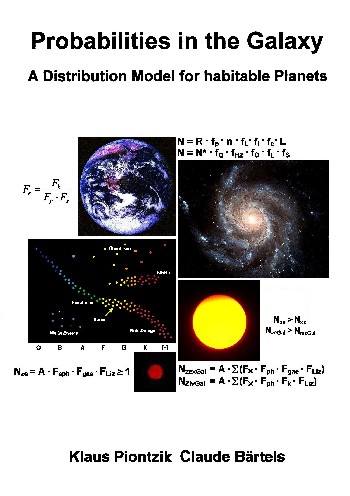Probabilities in the Galaxy
A Distribution Model for Habitable Planets
Copyright © Klaus Piontzik
The procedure used in the chapters of the book
is called an axiomatic approach in mathematics.
From the analysis of empirical data from the
Kepler satellite, hypotheses are drawn which are
referred to as approaches and axioms.
The statements derived from this are formulated
as sentences to which certain probabilities are assigned.
All axioms and theorems lead to an overall representation
of the situation, which can then be used as a working hypothesis.
As a working hypothesis regarding the frequencies of habitable,
Earth-like planets, as well as life, intelligence and civilizations in our galaxy.
It is unlikely that we are alone in the universe. It is more likely that we are not alone.
Based on these considerations, an old question of humanity can finally be answered. Therefore, the following working hypothesis can be formulated:
It is unlikely that we are alone in the universe. It is more likely that we are not alone.
Based on these considerations, an old question of humanity can finally be answered. Therefore, the following working hypothesis can be formulated:
We are not alone
The book was created from the mathematical part of the "Alien Hypothesis". The work "Probabilities in the Galaxy for Life, Intelligence and Civilization" forms a closed, unified working hypothesis that describes the distribution of habitable planets, life, intelligence and civilization in our galaxy. In addition, it was possible to integrate the Drake equation and the Seager equation into the model.
Introduction
The procedure used in the following chapters of the book is known in mathematics as the axiomatic approach. It forces you to clearly formulate all the requirements. This prevents hidden premises from creeping in.
From the analysis of existing empirical data from the Kepler telescope, hypotheses are drawn, which are referred to as approaches and axioms. The statements derived from this are formulated as sentences. All axioms and theorems lead to an overall representation of the situation, which can then be used as a working hypothesis.
It should be noted here that the following treatise is not an exact calculation method for determining the number of extraterrestrial civilizations, but rather a size estimate using statistical methods, based on data that is as reliable or empirical as possible. This paper also aims to show how one can develop a systematic model for life, intelligence and civilization in the galaxy.
The theory presented in this book, i.e. all the assumptions, approaches, axioms and sentences mentioned in the chapters are, in the sense of today's epistemology, falsifiable. So can be confirmed or refuted in the future. Thus, the model formulated here (specifically equation system 6.3.3, equation 8.4.2 and equation 12.2.2) fulfills the property of falsifiability, in Popper's sense, and thus represents a scientific hypothesis regarding the existence of extraterrestrial civilizations in a galaxy.
Furthermore, the model is a fundamental contribution to exobiology, namely the existence of (intelligent) life in the galaxy.
For the sake of completeness and comprehensibility, we have published almost the entire model. This makes it possible for everyone to recalculate all the numbers themselves.
This series of mathematics may be a bit tiring for a normal reader, but we found it necessary in order to maintain sufficient transparency and make the derivations comprehensible.
The procedure used in the following chapters of the book is known in mathematics as the axiomatic approach. It forces you to clearly formulate all the requirements. This prevents hidden premises from creeping in.
From the analysis of existing empirical data from the Kepler telescope, hypotheses are drawn, which are referred to as approaches and axioms. The statements derived from this are formulated as sentences. All axioms and theorems lead to an overall representation of the situation, which can then be used as a working hypothesis.
It should be noted here that the following treatise is not an exact calculation method for determining the number of extraterrestrial civilizations, but rather a size estimate using statistical methods, based on data that is as reliable or empirical as possible. This paper also aims to show how one can develop a systematic model for life, intelligence and civilization in the galaxy.
The theory presented in this book, i.e. all the assumptions, approaches, axioms and sentences mentioned in the chapters are, in the sense of today's epistemology, falsifiable. So can be confirmed or refuted in the future. Thus, the model formulated here (specifically equation system 6.3.3, equation 8.4.2 and equation 12.2.2) fulfills the property of falsifiability, in Popper's sense, and thus represents a scientific hypothesis regarding the existence of extraterrestrial civilizations in a galaxy.
Furthermore, the model is a fundamental contribution to exobiology, namely the existence of (intelligent) life in the galaxy.
For the sake of completeness and comprehensibility, we have published almost the entire model. This makes it possible for everyone to recalculate all the numbers themselves.
This series of mathematics may be a bit tiring for a normal reader, but we found it necessary in order to maintain sufficient transparency and make the derivations comprehensible.


